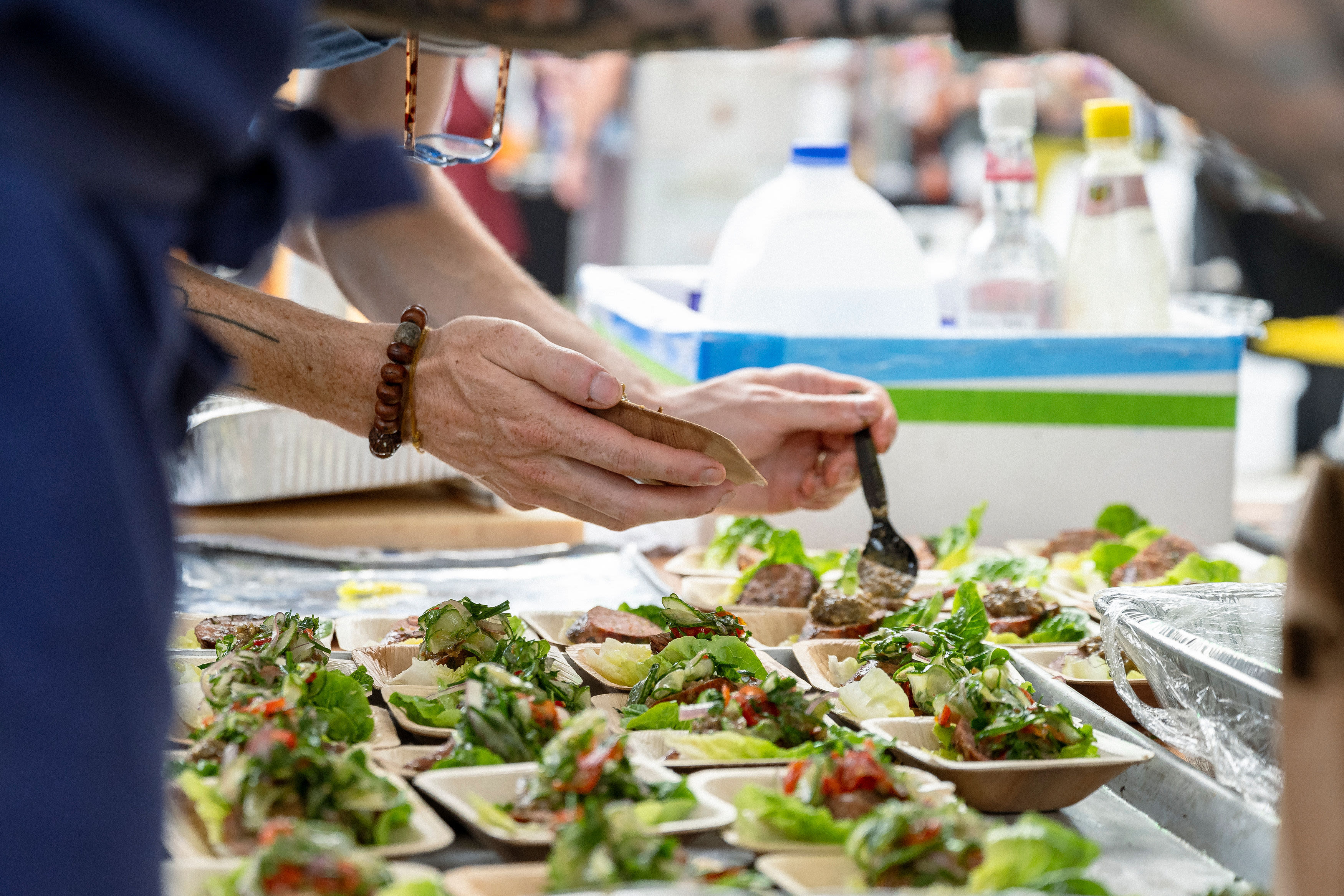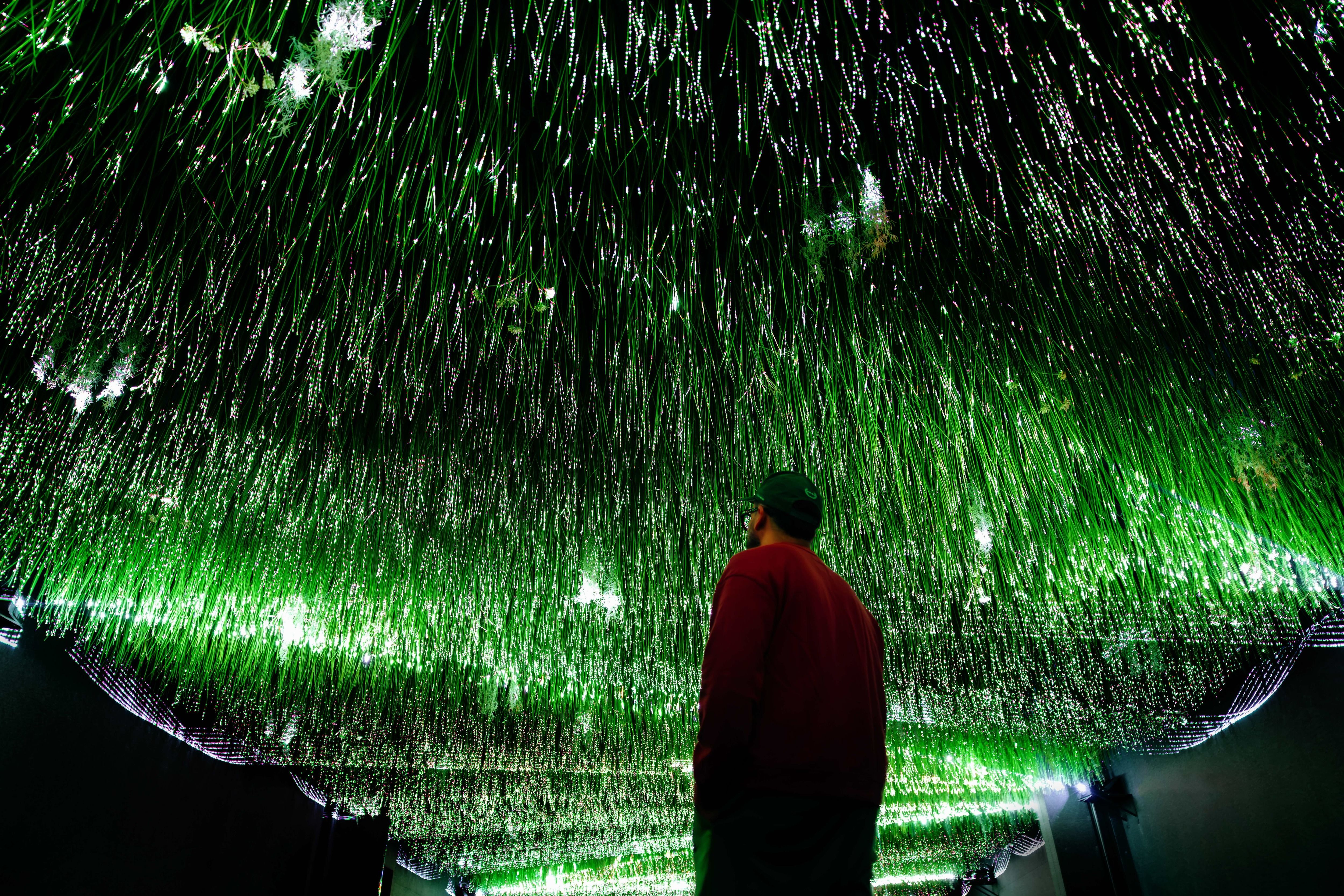One Year Later, Houston’s Art Lab Program in Discovery Green Faces Uncertainty

Water is a key feature at beloved downtown park Discovery Green. There’s the little duck pond flush with local flora and fauna, and, of course, the splash pad, well-attended by children in the summertime. But there’s a new wave lapping at the verdant grasses, one of mirrored metal rather than liquid. The views ebb and flow, revealing different figures in colorful clothes. Visitors can flip vertical panels to create new, human figures.
“Chroma Collective is about community. It is about all pushing to the same direction,” its artist, Karen Navarro, says. “…It has this undulated shape that, for me, is like a river where the current takes all of us to the same place.”
Last year, Discovery Green launched its Art Lab program, pairing mentor Jen Lewin with Navarro and fellow local artist Gerardo Rosales for comprehensive lessons in designing, pitching, and constructing public artworks. Sixty-three individuals applied for the prestigious new opportunity, which also included a $4,500 stipend and priority consideration for future artist calls. Navarro and Rosales were chosen based on a number of different factors that impressed the Discovery Green selection committee; their intuition proved correct when Chroma Collective was chosen for installation in the park, where it will be on display until November 2.
The sculpture, which more than 261,000 Discovery Green visitors have viewed since its unveiling on September 12, reflects a uniquely Houston perspective on multiculturalism. The artist used her own Latin American, Indigenous, and European cultural heritage and immigrant experience as a starting point. From there, she infuses imagery of rodeos and aguayo—a colorful and sturdy fabric woven by the Aymara people of South America. Ensuring Chroma Collective authentically reflects Houston’s diversity, Navarro also outsourced some of her decisions to the public. “How can I represent diversity in only four to six portraits? It’s very difficult to not fall into stereotypes if I’m choosing who is going to be represented in the work,” she says. “So, I decided to open a call…the decision wasn’t in my hands, but rather in the people.” She welcomed suggestions regarding who to include and how, then asked for the community to vote on their favorites, turning her concept into something more collaborative than she initially envisioned.
After Chroma Collective comes down on November 2, the future of the Art Lab program as an incubator for promising public art talent is unclear. Discovery Green leadership is now preparing itself for the possibility of losing $550,000 in funding from an anonymous national donor by year two, as their continued support is contingent upon local sponsors stepping up as well. Patronage and philanthropy can be challenging to come by, with more and more organizations struggling to meet their financial goals. Art Lab is now relying on Houston-based donors to continue the program, but now there’s more competition for funding.
Kathryn Lott, president of Discovery Green Conservancy, says the initial agreement was that the anonymous donors would fund the program’s first year. “They believed that the real measurement for success for them was then whether or not the philanthropic community of Houston, Texas, would invest… They wanted to not be the only funder.”
Still, public art is one of the most accessible ways for the community to engage with sculpture, installation, painting, and other media. It beautifies the neighborhood, too, adding unique character and encouraging more Houstonians to get out of the house and congregate near the works, learning more about both art and one another. “I think that being able to reach everyone—that’s what I do like about public spaces,” Navarro says.

For example, Lewin’s debut Art Lab piece, the interactive ATLAS—inspired by endangered moths and their critical role in the environment—reached over 550,000 people during its run from November 2024 through February 2025. Public art has the potential to spark ideas and conversations with a broader audience than a traditional gallery or museum setting. “To me, whether you want to just enjoy the work visually or engage in a deeper conversation…it’s fine,” Navarro says. “Of course, everyone will give the work the meaning and understand the work differently.”
While a Houston-based program, Art Lab was never intended to benefit only Space City. Navarro and Rosales received a comprehensive education to help them pitch their concepts to any opportunity in the world. Their gifts and their messages can travel, bringing all the positives of public art along with them. Maybe, in time, they will come to mentor other public artists in the same way Lewin did for them. Lott also points out that many of the civic art projects featured at Discovery Green create jobs that benefit the local economy; she mentions fabricators, electricians, and the trucking industry as contributors to the success of a piece.
Despite the funding challenges, Lott remains optimistic about the possibility of continuing Art Lab someday in the future. Discovery Green will still feature public art and fill its calendar with free and low-cost events for Houston families, which could educate visitors on why the arts are so integral to society and attract potential donors eager to fund mentorships.
Should the community rally behind funding the Art Lab program, Lott hopes to approve more than two local artists as the recipients of the grants and education. As far as she’s concerned, though, through ATLAS, Chroma Collective, and the opportunities that have opened up to the first round of mentees since completing their studies, Art Lab is a proven success.
“I’m so, so thrilled to watch them as they build into this new [public art] space and watching them just catapult from here,” Lott says, noting Navarro’s increased visibility since her mentee days. “…I really look forward to Art Lab living.”




